
 |
Eager Space | Videos by Alpha | Videos by Date | All Video Text | Support | Community | About |
|---|

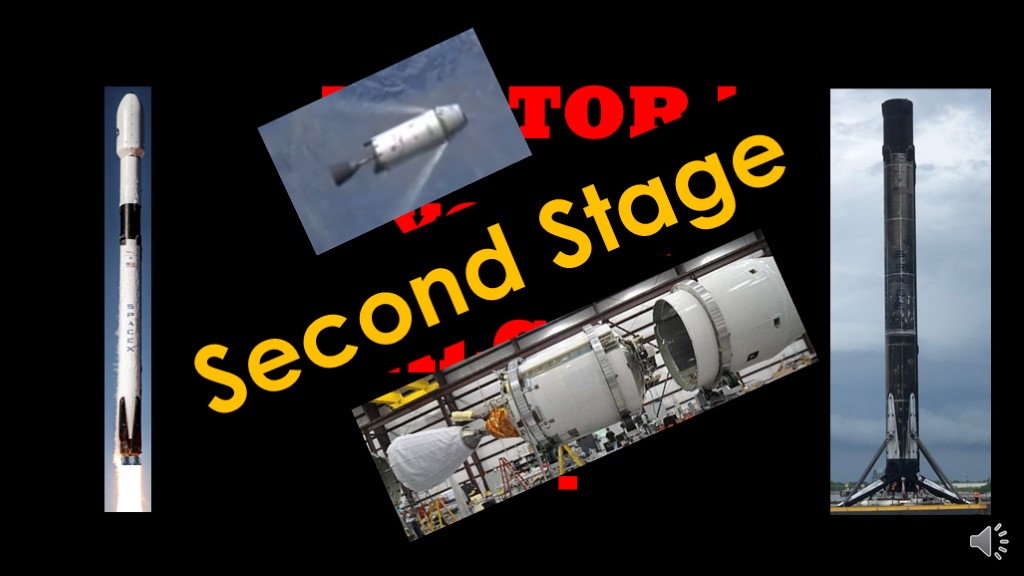
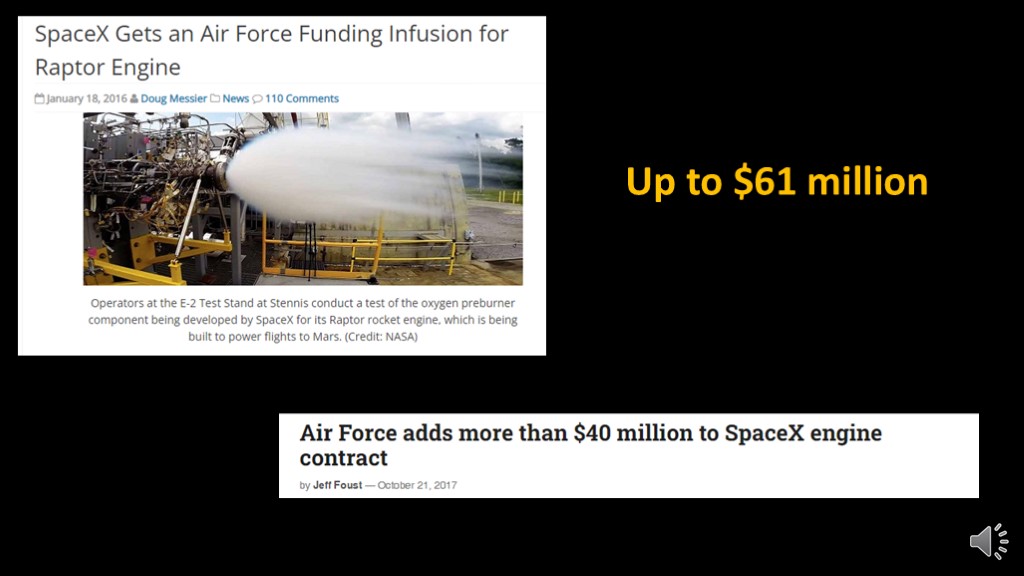
The air force help fund Raptor development for possible use on a falcon 9 second stage. This would be a smaller raptor to better fit the size needed for the Falcon 9. The air force put in a chunk of money - up to $61 million initially, and then more than $40 million a year later.
Why was the air force interested in a different engine? That requires a bit of an explanation...
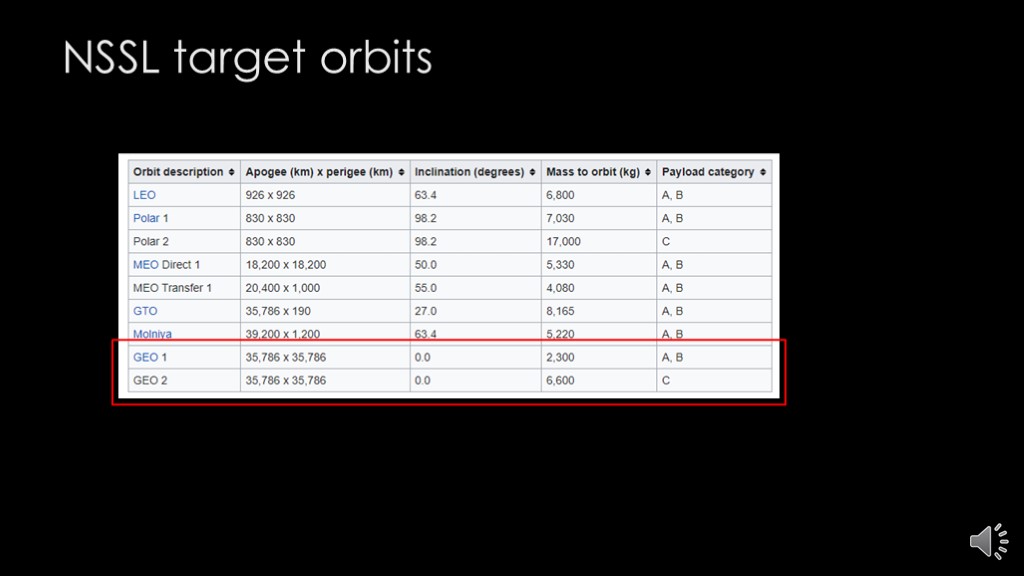
This goes back to the Air Force - now Space Force - launch requirements. The air force was looking for new options to launch their satellites, since they were fully dependent on ULA's Atlas V and Delta IV launchers. These launchers were very reliable but they were also very expensive.
To win part of the NSSL contract, you need to be able to hit all of these orbits. The top 7 are relatively easy, but there are two at the bottom that are hard to get to. They are geostationary orbits that require the launcher to do a lot of work. Let's explore why.
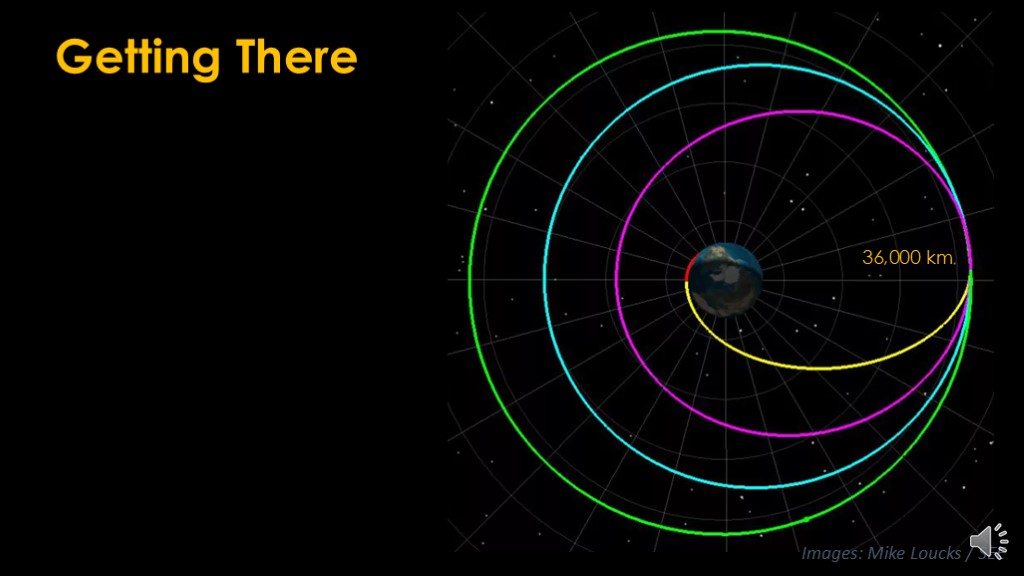
Here's a diagram that should help.
The goal for a geostationary payload is to get out to about 36,000 km and establish a circular orbit. This first diagram shows the launch, with the red part showing powered launch and the yellow part showing a long coast phase. This initial boost puts the payload what is known as a geostationary transfer (GTO) orbit. But there's a problem - only the high part of the orbit - the apogee - is at the proper altitude; the lower part of the orbit (the perigee) is still close to the earth. To get to the proper orbit we need to do this by circularizing the orbit; by thrusting at the apogee, we can change the orbit progressively #press #press #press until we hit the circular orbit we want. There also may be an adjustment to the orbital inclination at the same time.
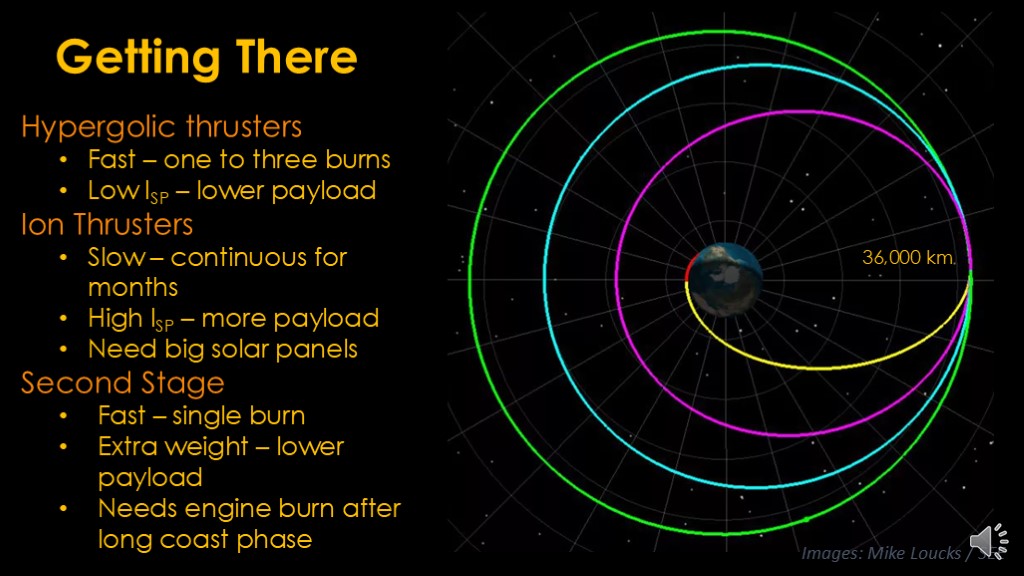
There are three basic ways to do this.
The first is with hypergolic thrusters built into the payload. These thrusters put quite a bit of thrust, so they can circularize the orbit in one to three burns. This was the most common way of doing circularization for a long time, though it does have a relatively low Isp and therefore a lower payload capacity.
The second way is to use ion thrusters - sometimes known as electric propulsion - on the payload. These thrusters put out very low thrust and therefore need to run continuously for months to circularize the orbit, but they have an Isp around 2000 or maybe higher, so that means smaller fuel tanks and therefore larger payload capacity and/or longer lifespan. They do require large solar panels to supply the electrical power, but big communications satellites already have large solar panels, so that works out well. Pretty much all the new GEO communications satellites use ion thrusters.
The third way is to use the engines built into the second stage. Those are generally pretty big, so they can do everything in a single burn, but there are two downsides.
The first is that both the payload and the second stage need to be circularized, and that reduces the payload significantly because you are circularizing both the payload and the second stage.
The second is that it takes a long time to get out there - 5 hours or more - and that means the second stage needs to last for that long so that it can perform the burn. That's especially hard for a Falcon 9, because it needs to keep its RP-1 fuel warm for 5 hours so it can perform the burn. That second problem is why the air force was interested in a different second stage engine.

That's not why you came here, however, so let's move on to talking about putting a raptor on the Falcon 9 second stage.
The results of putting the raptor on the first stage were less exciting than many had hoped. Will it be different this time? Let's see...
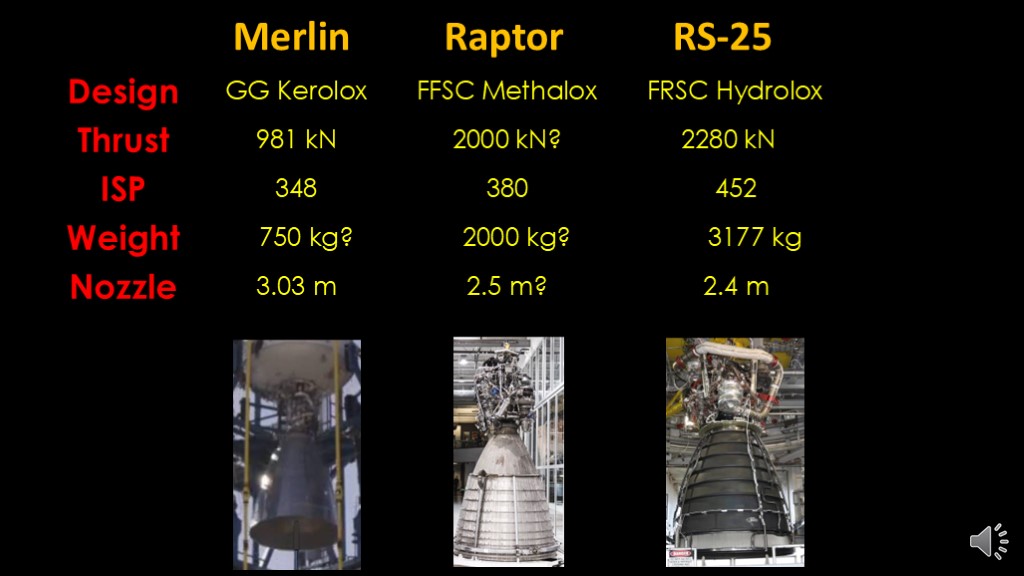
Let's talk about the competition...
The Merlin Vacuum engine is a Gas Generator engine, using RP-1 (refined kerosene) and liquid oxygen, or kerolox.
Going up against the Merlin is the Raptor, a full-flow staged combustion engine using liquid methane and liquid oxygen, or methalox.
And, just to have some fun, I decided to add in the venerable RS-25 or space shuttle main engine. It's a fuel-rich staged combustion engine using liquid hydrogen and liquid oxygen, or hydrolox
Going through some parameters, the Merlin puts out 981 kilonewtons of thrust, the Raptor puts out around 2000 kilonewtons - all raptor numbers are estimates - and the RS-25 puts out 2280 kN.
For Isp, the Merlin has a healthy 348, the Raptor 380, and the RS-25 wins with an Isp of 452.
I couldn't find an exact weight for the Merlin, so I added about 50% to account for the added size and complexity and got 750 kilograms. The raptor is probably around 2000 kilograms, and the RS-25 is a hefty 3177 kilograms.
Finally, the nozzle size of the Merlin is 3.03 meters, which fits inside the 3.7 meter diameter of the Falcon 9. The Raptor is smaller at around 2.5 meters, and the RS-25 is still smaller at 2.4 meters.
There's an interesting question here - why do these big vacuum engines have such a smaller nozzle than the Merlin. Both the Raptor and RS-25 have regenerative nozzles that are cooled by passing one of the propellants through them, but if you want to test them before launch - and you do - they have to have nozzles that are small enough to remain stable at sea level. And of course the RS-25 had to function at liftoff for the shuttle. Most of the Merlin nozzle has no cooling channels, so it can be tested without most of the nozzle. The raptor also has to fit in the space provided in starship. The larger nozzle is one reason the Merlin is so close in Isp to the challengers.
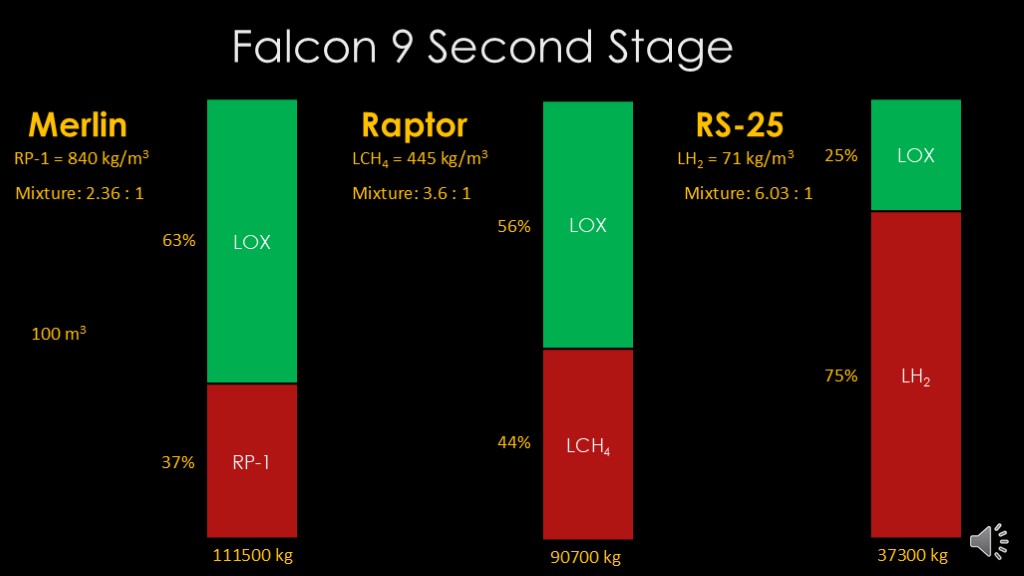
We'll start by seeing how our engine choices affect our propellant load.
The Merlin burns RP-1 which has a density of 840 kilograms per cubic meter, and runs at a mixture ratio of 2.36 parts oxygen to 1 part RP-1. If we know the second stage holds about 100 cubic meters of propellant, that amounts to 63% liquid oxygen and 37% RP-1 by volume. The total amount of propellant is around 111,000 kilograms.
Moving onto the raptor, it burns liquid methane which has a density of 445 kilograms per cubic meter, which is about half the density of RP-1. That would lead us to expect it to require about double the space for the liquid methane, but the mixture ratio is higher - more liquid oxygen - so when we do the math it turns out that the stage would be 56% lox, 44% liquid methane. Removing some lox and replacing the RP-1 with liquid methane reduces the mass of the propellant we can carry, down to around 90,000 kg, or about 20% less.
Finally, the RS-25 burns liquid hydrogen with a density of only 71 kilograms per cubic meter. It makes up a bit my having a high mixture ratio, but even with that we end up with a LOX tank that's only 25% of the total and the remaining 75% is needed for liquid hydrogen. That drastically reduces the amount of propellant we can carry, down to about 37,000 kg. The low density of liquid hydrogen is a big issue for designs that use it.
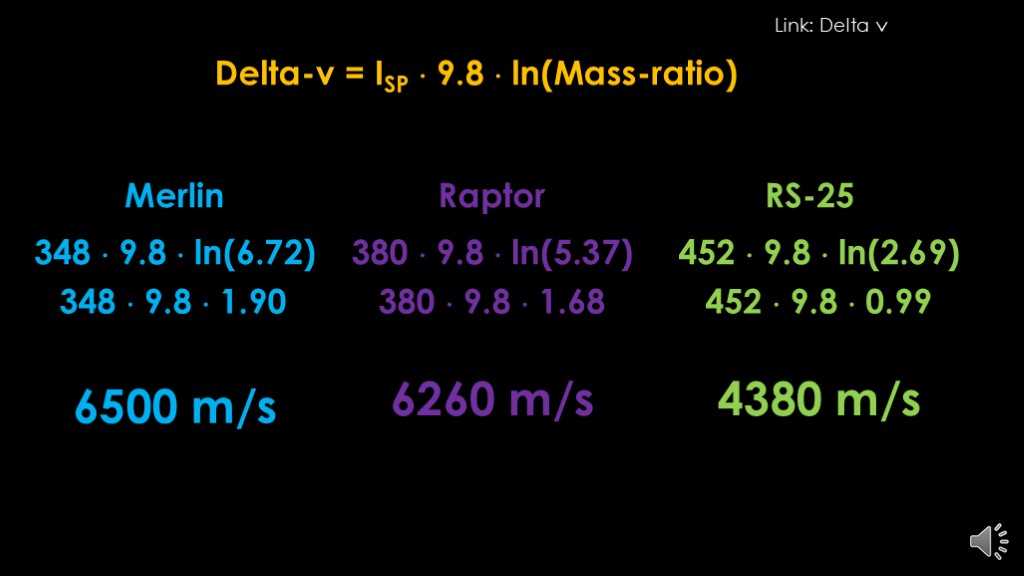
Now we can look at the results we get from those stages. We'll be talking about delta-v, so I put a link up in the corner to another video.
The Merlin has a low Isp - only 348 but is crams a bunch of propellant into the stage, so that gives is a high mass ratio - the ratio to the mass fully fueled to the mass empty. That gives is a delta-v of about 6500 meters per second.
The Raptor has a higher Isp but a worse mass ratio because we could only put 80 % as much propellent in the stage. It comes out at 6260 meters/second, which is in the same ballpark as the Merlin.
The RS-25 has a great Isp, but it falls down on the mass ratio, and that essentially kills its performance, only netting about 4380 meters per second of delta v, a distant third.
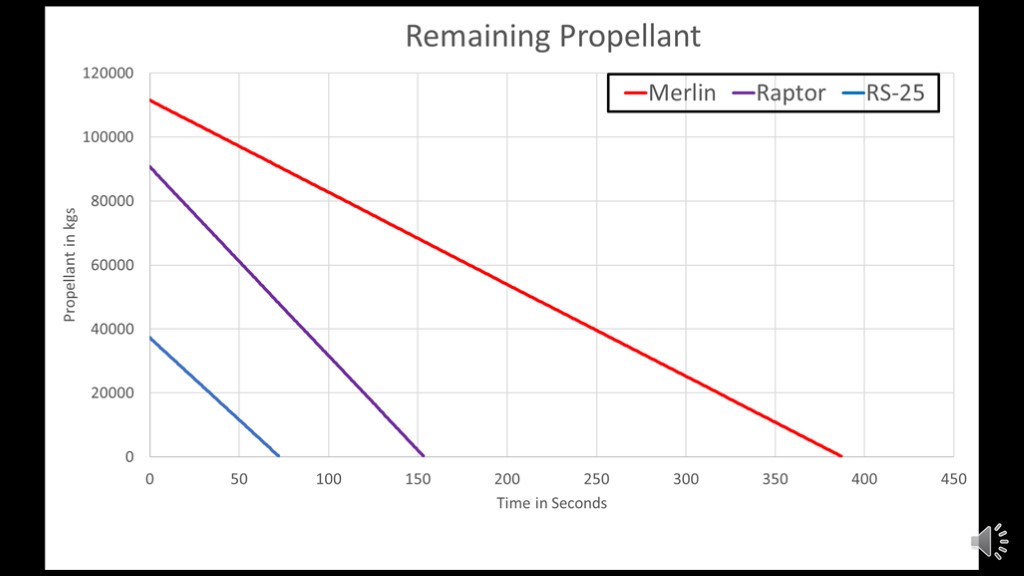
One of the other factors that affects performance is gravity losses, so I wanted to see if I could calculate the gravity losses for each option, but I ran into another issue.
The merlin vacuum launching a starlink payload will burn for somewhere around 380 seconds. The more powerful raptor with less propellant will burn for about 155 seconds. And the much lighter RS-25 version will only burn for about 70 seconds.
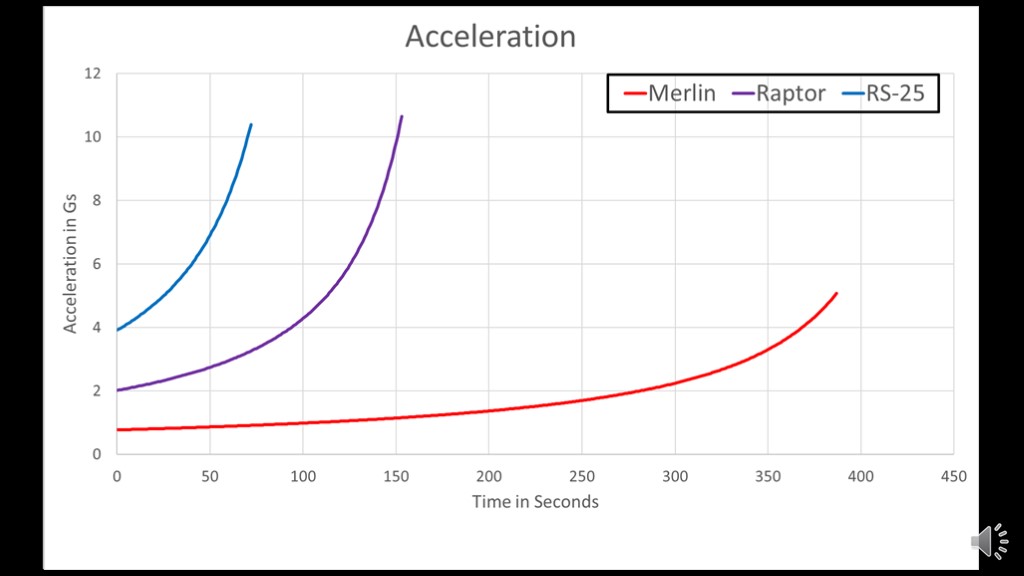
The short burn times coupled with the high thrust create a problem. The Merlin starts at a bit less than a G and then will end up at a bit over 5 Gs if it's not throttled down.
The Raptor starts and 2 Gs and rapidly increases, hitting nearly 11 Gs.
And the RS-25 starts at 4 Gs and also trends up above 10 Gs.
The engines can be throttled down a bit, but not really enough to fix the issue, and at lower thrust their Isp will be reduced.
It turns out there was a reason the air force wanted a smaller raptor...
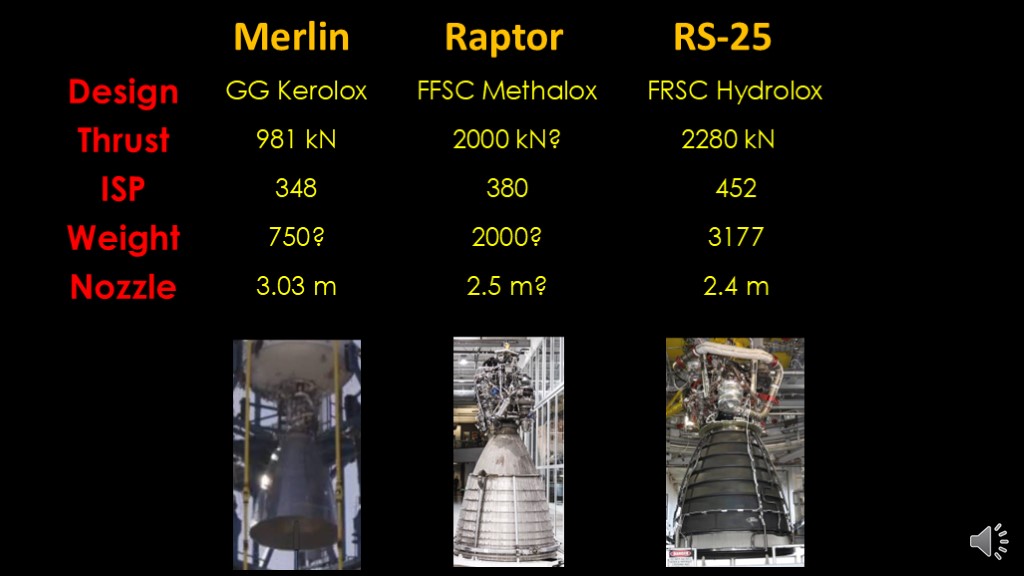
Let's see what we can do.
The Raptor is roughly twice the power we need, so I'm going to create a new engine.
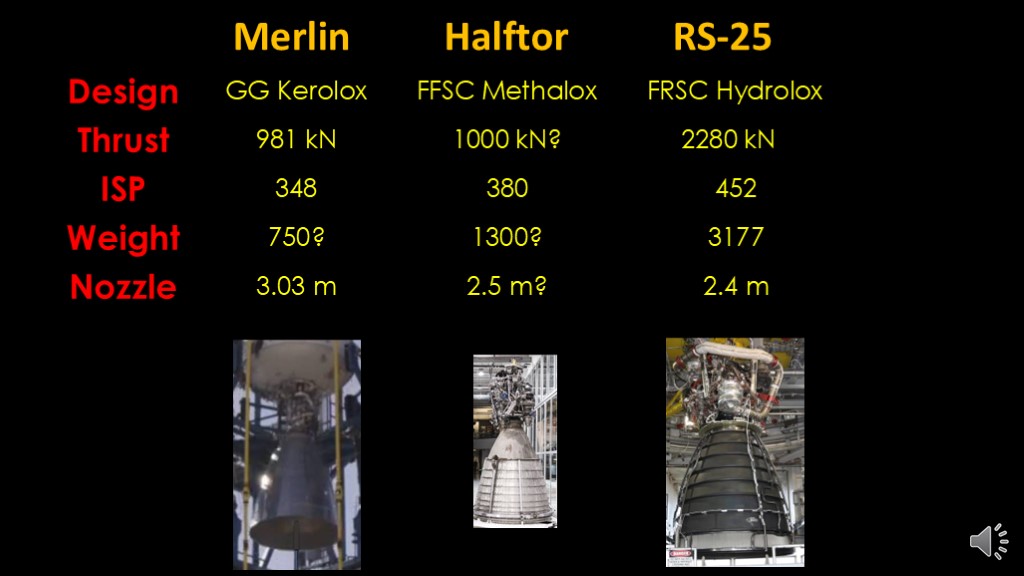
It's known as the Halftor, with a thrust of 1000 kN, and it's only going to mass 1300 kg because it's smaller.
The RS-25 is even more overpowered than the Raptor because the stage is so light, so we're going to need to go to one quarter scale
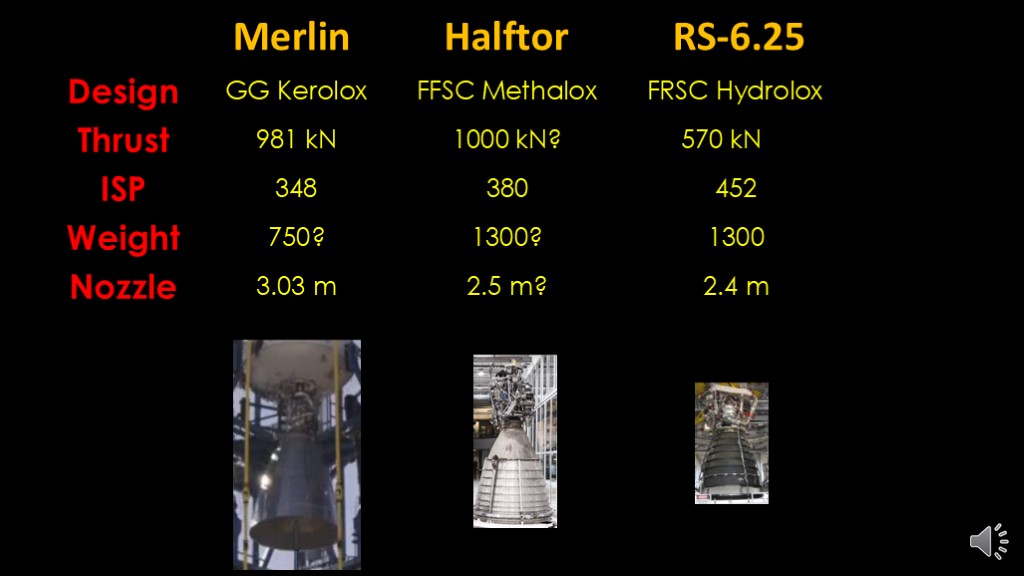
That will be the RS-6 point two five, with 570 kN of thrust and only 1300 kg of mass
How will these work?
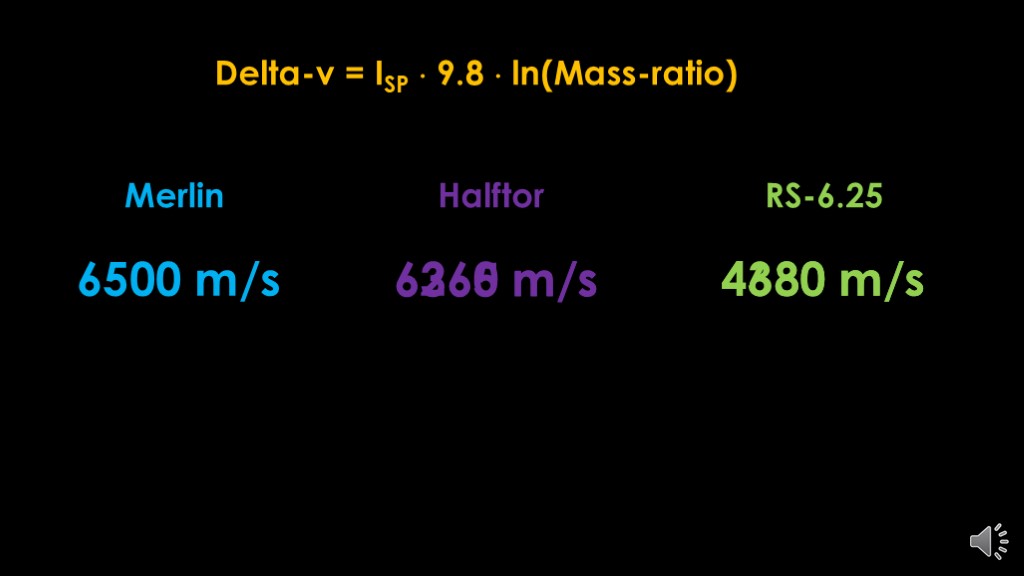
We can now rerun the delta V calculations as the engines are lighter.
The halftor moves up 100 meters per second to 6365 meters per second.
The RS-6.25 moves up 250 meters per second to 4630 meters per second.
That's a pretty good gain for both of them, but still less than the Merlin.
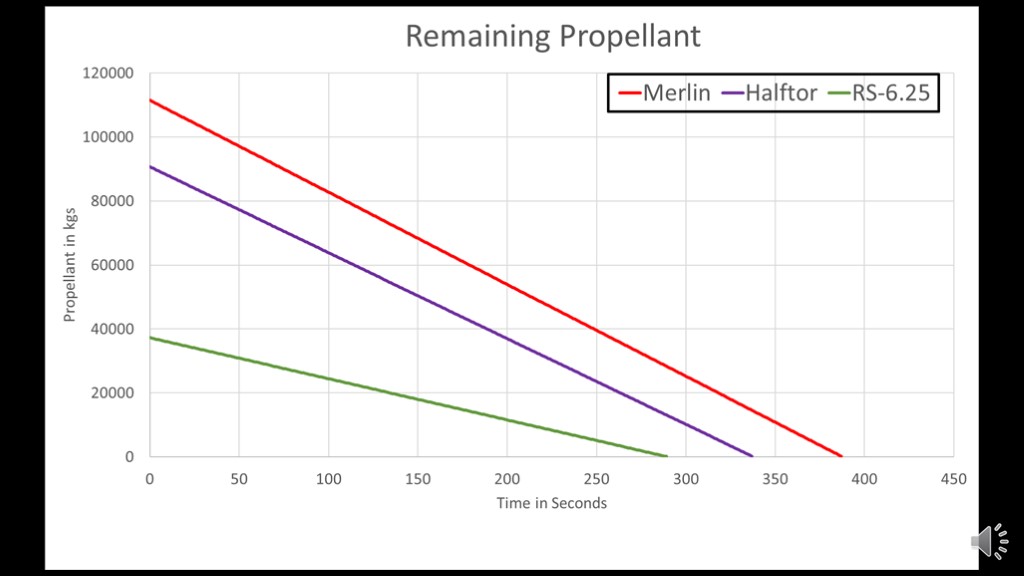
Now we can flip back and look at our graph of remaining propellant and we can see that now both of the candidate motors run for a whole lot longer. The halftor runs for 330 seconds and the RS 6.25 runs for about 285 seconds, which is much more reasonable..

With the acceleration graph we see the Halftor reaches about the same acceleration as the Merlin. It finishes a bit faster, so it's going to gain a bit in gravity losses, which will put the Merlin and the Halftor closer together.
The RS 6.25 follows a similar curve to the other engines, but it kindof burns out a bit too early because of the amount of propellant. It's not really possible to give it both the higher thrust and the longer burn time because of the lack of propellant mass.
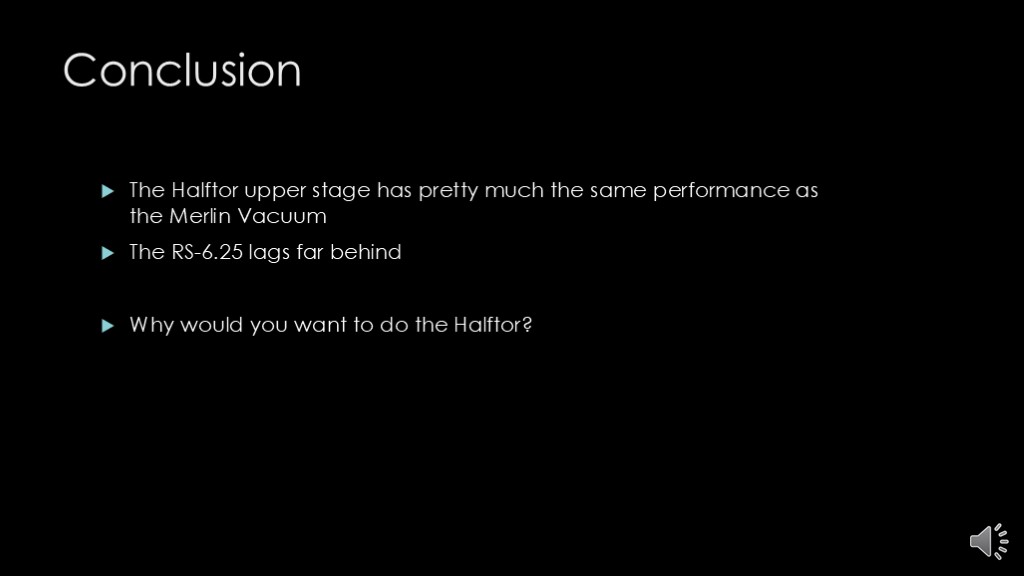
Now that we've done our analysis we can reach our conclusion
The halftor upper stage doesn't have any real advantages over the merlin, and the RS-6.25 lags far behind as it simply does not pack enough propellant to be competitive.
Why would you want to do the halftor?
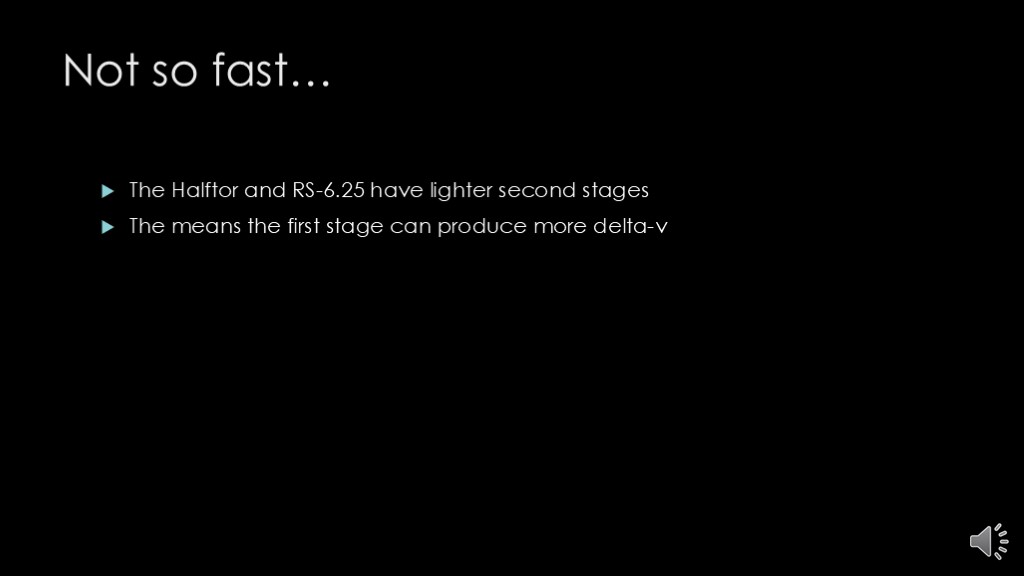
Not so fast!
As we noted earlier, both the halftor and the Rs 6.25 end up being lighter than the Merlin simply because their propellant weighs less.
This means the first stage can produce more delta-v...
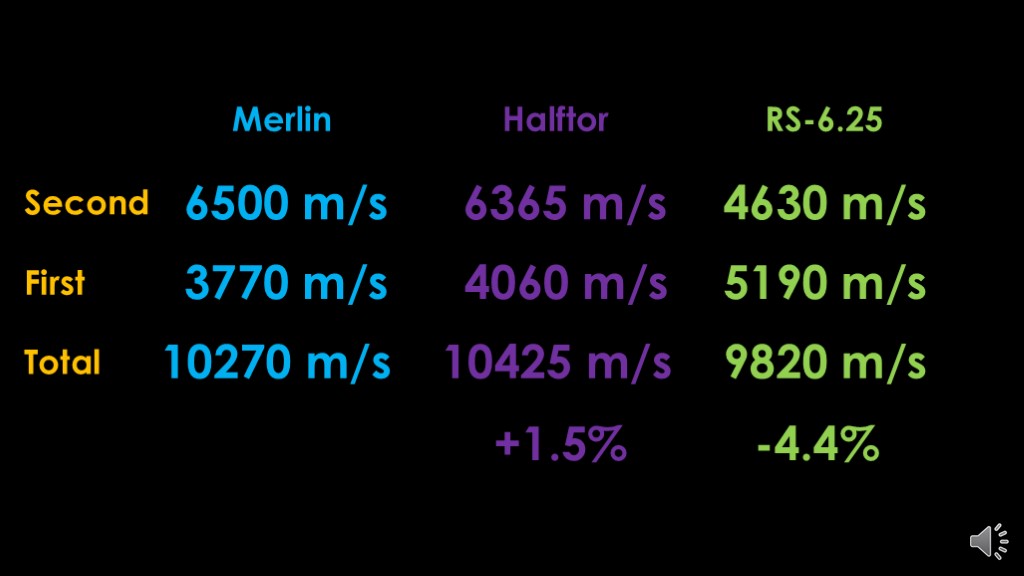
Skipping the math to get new numbers, we'll start with the second stage delta-v for each of the options.
Then we can add in the first stage.
For a star link launch, with the merlin, the first stage gives 3770 meters per second and the full stack nets a total of 10,270 meters per second.
Going to the Halftor, the first stage goes up to 4060 meters per second and the full stack nets a total of 10, 425 meters per second. That's 1.5% more, and there's probably a little more than that with reduced gravity losses in the second stage.
The RS-6.25 puts up a strong showing with a first stage of 5190 meter per second and a toal of 9820 meter per second, only 4.4% less than the Merlin. The lightness of the second stage redeems itself a bit, but it's still not competitive.
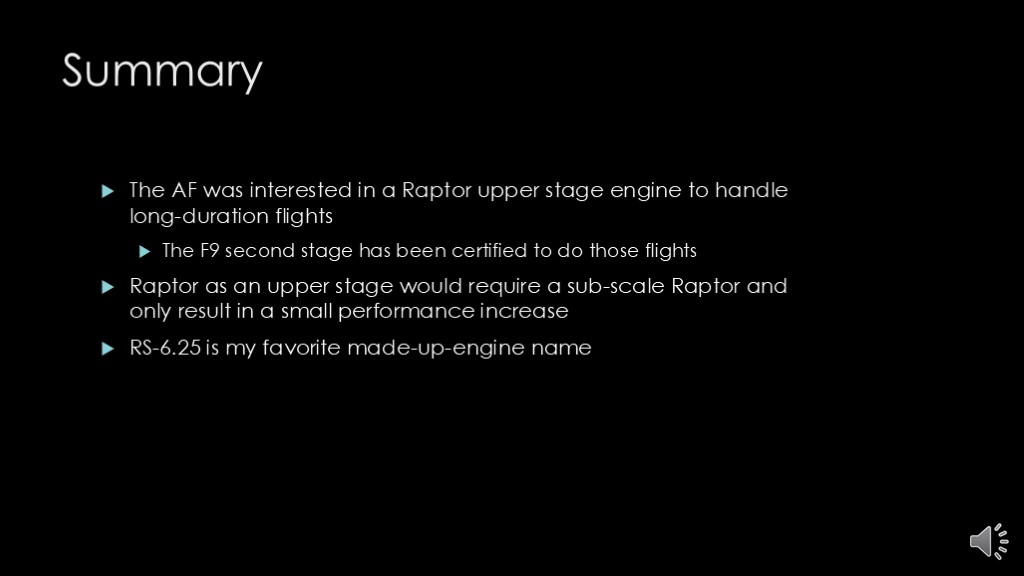
What did we learn?
First, the Air Force was interested in the Raptor upper stage engine primarily to handle long duration flights that go directly to geostationary orbit. In 2020 the F9 was certified to do those flights, so this is not longer an issue from the air force or I guess the space force perspective.
Second, to use raptor technology on the Falcon 9 would require a smaller engine and it would only produce a few percentage points of performance gain. It's unlikely to be worth it financially and that's why SpaceX is no longer working on it.
Third, the RS-6.25 is my favorite made-up-engine name

